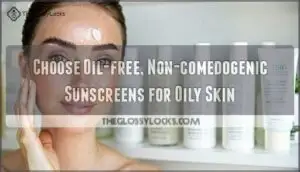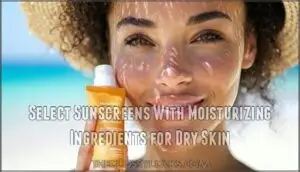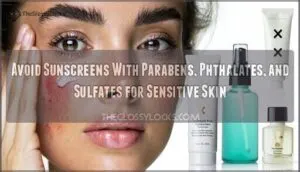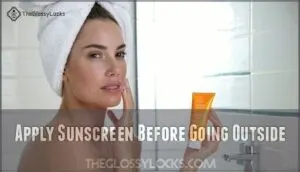This site is supported by our readers. We may earn a commission, at no cost to you, if you purchase through links.
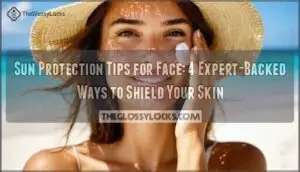
Apply enough to cover your entire face – about a nickel-sized amount – and don’t forget your neck, ears, and lips. Reapply every two hours, especially after sweating or swimming.
For oily skin, pick oil-free, non-comedogenic options. Dry skin benefits from moisturizing sunscreens with ingredients like hyaluronic acid.
Sensitive skin should avoid harsh chemicals like parabens and sulfates. The two-finger rule helps guarantee proper application coverage.
These sun protection tips for face care form the foundation of healthy skin habits that pay dividends over time.
Table Of Contents
- Key Takeaways
- Daily Face Sun Protection
- Sunscreen for Face
- Top 4 Face Sunscreens
- Face Sun Protection Techniques
- Long Term Face Sun Protection
- Frequently Asked Questions (FAQs)
- What can I put on my face to protect from sun?
- What are the 5 S’s of sun protection?
- What are the best sun protection tips?
- Can sunscreen cause acne breakouts?
- Should I wear sunscreen under makeup?
- How does tinted sunscreen compare to regular?
- What SPF level is best for daily use?
- Do I need sunscreen on cloudy days?
- Conclusion
Key Takeaways
- You’ll need to apply broad-spectrum sunscreen with at least SPF 30 daily to your face, neck, ears, and lips – even on cloudy days – using about a nickel-sized amount and the two-finger rule for proper coverage.
- You must reapply sunscreen every two hours throughout the day, or immediately after swimming, sweating, or any activity that removes the protective barrier from your skin.
- You should choose sunscreen formulas that match your skin type – oil-free and non-comedogenic for oily skin, moisturizing ingredients like hyaluronic acid for dry skin, and mineral-based options without harsh chemicals for sensitive skin.
- You’re protecting yourself from serious long-term consequences including skin cancer, premature aging, wrinkles, and dark spots by making daily sun protection a non-negotiable habit that pays dividends for decades.
Daily Face Sun Protection
Your face takes a beating from the sun every single day, even when you’re just running errands or sitting by a window.
Daily sun damage adds up faster than you think, even indoors.
Starting a daily face protection routine now can save you from wrinkles, dark spots, and skin cancer down the road.
Apply Sunscreen Every Day
Making daily sunscreen application your non-negotiable habit protects against indoor UV exposure through windows and incidental sun exposure during brief outdoor moments.
Even on cloudy days, UV rays penetrate clouds, making year-round necessity clear.
Your consistent daily routine with quality facial sunscreen shields skin from cumulative damage that builds over time, ensuring maximum protection.
Consider browsing options for daily facial products for optimal skin health, and make daily application a part of your routine.
Reapply Sunscreen Every Two Hours
Even the best sunscreen for face loses its power throughout the day.
You need to reapply facial sunscreen every two hours for consistent protection.
Activity impact matters too – sweating or swimming means more frequent reapplication.
Indoor reapplication is still important since UVA rays penetrate windows.
Set practical reminders on your phone or watch to maintain this reapplication frequency without forgetting, and consider the overall protection you need.
Use Broad-spectrum Sunscreen With at Least SPF 30
Most dermatologists recommend choosing a broad-spectrum sunscreen with at least SPF 30 for your face.
This minimum protection blocks 97% of harmful UVB rays while shielding against UVA damage that causes premature aging.
SPF effectiveness depends on proper application and reapplication frequency.
Daily use of the best face sunscreen guarantees consistent sun protection face coverage year-round.
Selecting a sunscreen with broad-spectrum protection is vital for guarding against both UVA and UVB rays, ensuring daily use and consistent sun protection.
Sunscreen for Face
Not all sunscreens work the same way for every face, and choosing the wrong one can lead to breakouts, irritation, or that dreaded white cast.
Finding the right sunscreen for your face shouldn’t feel like a chemistry experiment gone wrong.
Your skin type determines which sunscreens formula will protect you best while keeping your complexion happy and healthy, which is why selecting the right one is critical.
Choose Oil-free, Non-comedogenic Sunscreens for Oily Skin
If you’ve got oily skin, choosing the right sunscreen can feel like walking a tightrope.
Oil-free, non-comedogenic formulas won’t clog your pores or add extra shine to your T-zone. You can find a variety of sunscreen product options online.
- Look for "non-comedogenic" labels – these won’t block your pores or trigger breakouts
- Choose gel or water-based formulas – they absorb quickly without leaving residue
- Seek hyaluronic acid ingredients – provides hydration without heaviness
- Avoid thick, creamy textures – these can feel greasy on oily skin types
- Test patch areas first – confirms your skin won’t react negatively
Select Sunscreens With Moisturizing Ingredients for Dry Skin
If you have dry skin, you need sunscreen that pulls double duty as your daily moisturizer.
Look for hydrating sunscreen benefits from ingredients like glycerin and hyaluronic acid. These dry skin ingredients help lock in moisture while providing face sun protection.
Finding the right sunscreen products can be a game changer for dry skin.
Apply your sunscreen generously using proper sunscreen application tips, and remember sunscreen reapplication frequency matters for long-term skin health.
Avoid Sunscreens With Parabens, Phthalates, and Sulfates for Sensitive Skin
When you have sensitive skin, choosing the right sunscreen ingredients matters.
Skip products with parabens, phthalates, and sulfates—these common preservatives and chemicals can trigger irritation and breakouts.
Instead, look for irritant-free sunscreens with natural sunscreen options like zinc oxide or titanium dioxide.
Reading sunscreen labels becomes your best friend for spotting these troublemakers and finding chemical sunscreen alternatives that won’t leave your face red and angry.
Simplifying routines helps, as does using barrier-supporting ingredients to strengthen the skin.
Top 4 Face Sunscreens
Choosing the right sunscreen for your face can make daily protection easy and comfortable.
Here are four top options that work well for different skin types and needs, so you don’t have to guess in the sunscreen aisle.
1. La Roche-Posay Anthelios Sunscreen SPF 60
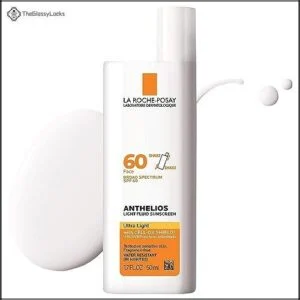
This award-winning facial sunscreen offers SPF 60 broad-spectrum protection with Cell-Ox Shield technology that fights both UV rays and free radicals.
You’ll love its lightweight, matte finish that won’t leave you looking greasy or ghost-white.
The oil-free formula works perfectly under makeup and won’t clog your pores, it’s water-resistant for 80 minutes and completely free from oxybenzone and octinoxate.
Perfect for sensitive skin types who need serious protection without irritation, making it an ideal choice with its broad-spectrum protection.
Best For: People with sensitive, oily, or acne-prone skin who need strong daily sun protection without irritation.
- Lightweight, matte texture feels comfortable and wears well under makeup.
- Broad-spectrum SPF 60 shields against both UVA and UVB rays, water-resistant for 80 minutes.
- Oil-free, non-comedogenic, and fragrance-free, minimizing breakouts and redness.
- Price is high for the amount of product.
- Can ball up or feel slightly dewy if too much is applied.
- May cause eye irritation if applied too close to the eyes.
2. COOLA Scalp and Hair Sunscreen SPF 30
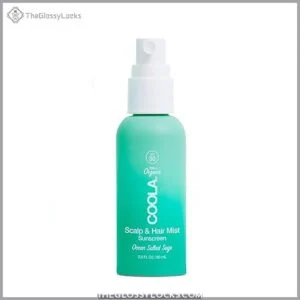
Beyond protecting your face, don’t forget about your scalp and hairline.
COOLA’s Scalp and Hair Sunscreen SPF 30 delivers broad-spectrum protection through a lightweight mist that won’t weigh down your hair.
With 70% certified organic ingredients and monoi oil, it prevents UV damage while keeping color-treated hair vibrant.
The water-resistant formula lasts 80 minutes, making it perfect for beach days when your hat flies off in the wind, providing broad-spectrum protection.
Best For: People with thinning, bald, or color-treated hair who want reliable scalp sun protection without heavy residue.
- Lightweight, non-greasy mist is easy to apply and absorbs quickly
- Provides broad-spectrum SPF 30 protection and is water-resistant for 80 minutes
- Made with over 70% certified organic, vegan, and reef-safe ingredients
- May leave hair slightly oily or clumpy, especially with fine hair
- Higher price point compared to similar scalp sunscreens
- Some users report packaging issues or nozzle inconvenience
3. Supergoop Mineral Mattescreen SPF 40
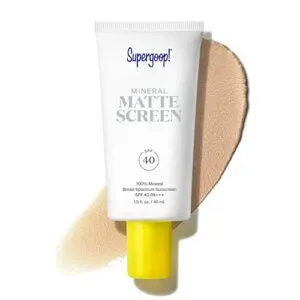
This premium mineral sunscreen delivers SPF 40 protection with a game-changing twist: it actually mattifies your skin.
You’ll get zinc oxide and titanium dioxide protection without the typical white cast, thanks to its neutral tint.
The whipped texture spreads easily and doubles as a makeup primer, blurring pores for that soft-focus effect.
It’s oxybenzone-free and perfect for sensitive skin, though some users report mixed results with oil control compared to other brands.
For sensitive skin, mineral-based formulations are often recommended.
Best For: Those with sensitive, combination, or oily skin seeking a matte finish, broad-spectrum mineral sunscreen that’s also suitable as a makeup primer.
- Lightweight, whipped texture with a neutral tint minimizes white cast and blurs pores.
- Doubles as a primer for smooth, matte skin and longer-lasting makeup.
- Oxybenzone-free, vegan, and non-comedogenic formula is gentle on sensitive skin.
- Expensive compared to similar mineral sunscreens.
- Mixed feedback on its oil control performance for very oily skin.
- Occasional user reports of breakouts or sunburn with extended use.
4. La Roche Posay Tinted Mineral Sunscreen
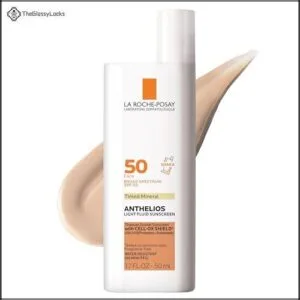
Looking for sunscreen that won’t leave you looking like a ghost? La Roche-Posay’s Tinted Mineral Sunscreen delivers SPF 50 protection with a subtle tint that blends seamlessly into most skin tones.
This lightweight formula contains titanium dioxide and iron oxides, offering broad-spectrum defense without the white cast typical of mineral sunscreens. You’ll get 40 minutes of water resistance and a natural matte finish that works perfectly under makeup.
While pricey, users consistently praise its comfortable feel and reliable protection.
Best For: Anyone looking for a lightweight, mineral-based sunscreen that offers high SPF and a natural tint without a white cast, especially those with sensitive or acne-prone skin.
- Price is high for the amount of product you get.
- Shade range may not suit all skin tones perfectly without mixing.
- Only water-resistant for 40 minutes, not ideal for long swim sessions.
- Gentle, non-greasy formula that feels light and comfortable for daily wear.
- Blends well for a natural, glowy finish and doesn’t leave a white cast.
- Fragrance-free, oil-free, and dermatologist recommended for sensitive skin.
Face Sun Protection Techniques
Getting your sunscreen application technique right makes all the difference between adequate protection and getting burned.
You’ll want to master these four key methods to guarantee your face stays shielded from harmful UV rays all day long, and ensure that your sunscreen application is effective.
Use The Two-finger Rule for Applying Sunscreen
Most people apply way too little sunscreen to their face.
The two-finger rule fixes this common mistake. Squeeze sunscreen along your pointer and middle fingers from base to tip.
This amount covers your face and neck properly. For ideal defense, consider broad-spectrum sunscreens to protect against both UVA and UVB rays.
Don’t skimp on sunscreen application – adequate coverage means better sun protection tips for face care.
Apply Sunscreen Before Going Outside
Timing your sunscreen application correctly makes all the difference in protection.
Apply sunscreen at least 15-30 minutes before stepping outdoors to allow proper absorption into your skin. This Early Application creates a protective barrier that won’t wash off easily with sweat or light moisture.
Here are five key timing strategies for effective sun protection:
- Morning routine integration – Apply sunscreen right after your skincare routine for Consistent Routine habits
- Indoor Prep advantage – Complete application indoors to avoid rushing and guarantee Thorough Coverage
- Pre-Exposure Timing – Allow 15-30 minutes for chemical sunscreens to activate properly
- Weather-independent application – Apply daily regardless of cloud cover for thorough sun damage prevention
- Makeup compatibility – Let sunscreen set before applying makeup to prevent pilling or separation
Reapply Sunscreen After Swimming or Sweating
Water and sweat wash away sunscreen, leaving your face vulnerable to UV damage.
You’ll need to reapply every two hours or immediately after swimming and sweating.
Even sweat-proof formulas break down with activity intensity, so don’t skip this step during water sports.
| Activity Type | Reapplication Timing | Water Resistance Level |
|---|---|---|
| Light sweating | Every 2 hours | Standard sunscreen |
| Heavy sweating | Immediately after | Water-resistant formula |
| Swimming/water sports | After each swim session | Very water-resistant |
| High-intensity exercise | Every 30-60 minutes | Sport-specific formula |
The table outlines the reapplication timing and water resistance level for different activity types, helping you choose the right sunscreen for your needs.
Use Hair Mists, Oils, or Powders With SPF for Scalp Protection
Your scalp needs protection too, especially where hair parts or thins. SPF hair products offer targeted coverage for vulnerable areas.
Consider these scalp protection options:
- Hair mists with SPF 30 – Spray 4-6 inches from scalp, distribute with fingers
- Mineral powders – Apply directly to part lines for matte, oil-absorbing coverage
- Natural oils – Raspberry seed or wheatgerm oil provide nourishment plus UV protection
Reapply every two hours, just like face sunscreen. Many mists offer broad spectrum protection against UVA/UVB rays.
Long Term Face Sun Protection
Protecting your face from the sun today prevents serious problems tomorrow.
When you make sun protection a daily habit, you’re investing in healthier skin that looks younger and stays cancer-free for years to come.
Reduce Risk of Skin Cancer and Premature Aging
Your face bears the brunt of daily sun exposure, making skin cancer prevention essential.
Cumulative exposure leads to DNA damage, increasing melanoma risk and facial aging. Actinic keratosis often appears as rough patches on sun-damaged skin.
| Risk Without Protection | Benefit With Protection |
|---|---|
| DNA damage accumulates daily | Prevents cellular mutations |
| Melanoma risk doubles after 5+ burns | Reduces cancer development |
| Actinic keratosis develops | Maintains healthy skin cells |
| Premature facial aging accelerates | Preserves youthful appearance |
Daily sunscreen tips create a protective barrier against these long-term consequences. When you protect your face from sun damage consistently, you’re investing in healthier skin for decades ahead.
Prevent Cosmetic Skin Issues Like Wrinkles and Hyperpigmentation
Beyond cancer prevention, consistent sunscreen use keeps your face looking younger by preventing visible signs of aging.
UV rays break down collagen and elastin, leading to premature wrinkles and dark spots that can make you look older than your years.
Daily sunscreen application helps maintain your youthful complexion by:
- Wrinkle Prevention – blocking UV rays that damage skin structure
- Hyperpigmentation Control – preventing dark spots and uneven skin tone
- Elasticity Preservation – maintaining skin’s natural bounce and firmness
- Sun Damage Repair – allowing existing damage to heal properly
Boost Cognitive and Mental Health With Safe Sun Exposure
Sun protection goes beyond skin deep – it’s your ticket to sharper thinking and happier days.
Smart sun exposure boosts your mood through serotonin production while supporting cognitive function.
Emerging research also suggests a link between sunlight and improved learning ability.
Here’s how to balance mental health benefits with skin safety:
| Benefit | How It Works | Safe Approach |
|---|---|---|
| Sunlight and Mood | Increases serotonin production | Morning/late afternoon exposure |
| Vitamin D Benefits | Supports brain health and neurogenesis | 15-30 minutes with sun protection tips for face |
| Cognitive Function Boost | Enhances memory and attention | Combine outdoor activities with SPF |
| Mental Health Impact | Regulates sleep-wake cycles | Use protective clothing during peak hours |
The key is finding your sweet spot – enough sun exposure for cognitive health and mental health perks without damaging your skin.
Make Sun Protection a Daily Habit for Optimal Results
Making sun protection a daily habit transforms your skin’s health. Like brushing your teeth, applying sunscreen becomes automatic with consistent application. This routine protects against incidental exposure and indoor UV rays that accumulate over time.
Here are five habits for ideal face protection:
- Apply sunscreen every morning – Make it part of your skincare routine
- Keep sunscreen visible – Place it next to your toothbrush as a reminder
- Use scalp protection – Don’t forget hair mists with SPF for exposed areas
- Reapply during lunch breaks – Set phone reminders for midday touch-ups
- Check expiration dates monthly – Replace old products for maximum effectiveness
These sunsafe habits deliver long-term benefits, preventing premature aging while reducing cancer risk through consistent protection.
Frequently Asked Questions (FAQs)
What can I put on my face to protect from sun?
Apply broad-spectrum sunscreen with SPF 30+ daily to your face, even on cloudy days. Use the two-finger rule for coverage and reapply every two hours for best protection.
What are the 5 S’s of sun protection?
Remember the five S’s: Shade, Sunscreen, Sleeves, Slop it on, and Sunglasses. You’ll protect yourself by seeking shade, applying broad-spectrum SPF 30+, wearing long sleeves, and using UV-blocking sunglasses consistently.
What are the best sun protection tips?
Daily sunscreen application with SPF 30+ protects against skin cancer and premature aging. Reapply every two hours, seek shade during peak hours, and wear protective clothing for complete coverage.
Can sunscreen cause acne breakouts?
Like a double-edged sword, sunscreen can trigger breakouts if you’re using the wrong formula.
Choose oil-free, non-comedogenic options designed for oily or acne-prone skin to keep your face protected without clogging pores.
Should I wear sunscreen under makeup?
Yes, you should wear sunscreen under makeup daily.
Sunscreen provides essential protection from UV rays that can penetrate through makeup alone.
Choose a broad-spectrum SPF 30+ formula that works well as a base for your makeup routine.
How does tinted sunscreen compare to regular?
In terms of beauty and function, tinted sunscreen kills two birds with one stone.
It provides the same UV protection as regular sunscreen while doubling as light foundation, making it perfect for makeup wearers seeking streamlined coverage.
What SPF level is best for daily use?
SPF 30 is the minimum recommended for daily use, blocking 97% of UVB rays. Higher SPFs offer increased protection but may feel stickier on your skin.
Do I need sunscreen on cloudy days?
Don’t let cloudy skies fool you—you still need sunscreen every day. UV rays penetrate clouds and cause skin damage, so apply broad-spectrum SPF 30 daily regardless of weather.
Conclusion
Remember the old saying: "An ounce of prevention is worth a pound of cure."
These sun protection tips for face care aren’t just beauty advice—they’re your skin’s insurance policy.
Start with daily SPF 30, reapply every two hours, and choose formulas that match your skin type.
Don’t forget your neck, ears, and lips.
Consistent protection prevents wrinkles, dark spots, and serious skin damage, making sunscreen your daily habit, and your future self will thank you.
- https://www.skincancer.org/skin-cancer-prevention/sun-protection/sunscreen/
- https://weather.com/atmosphere/reviews/best-sunscreen
- https://mcpress.mayoclinic.org/living-well/how-to-pick-out-the-best-sunscreen-for-you-including-ingredients-to-look-out-for/
- https://www.eucerinus.com/skin-care-101/sun-protection-skin-health-tips-and-skin-facts-for-uv-exposure
- https://www.cancer.org/cancer/risk-prevention/sun-and-uv/uv-protection.html

